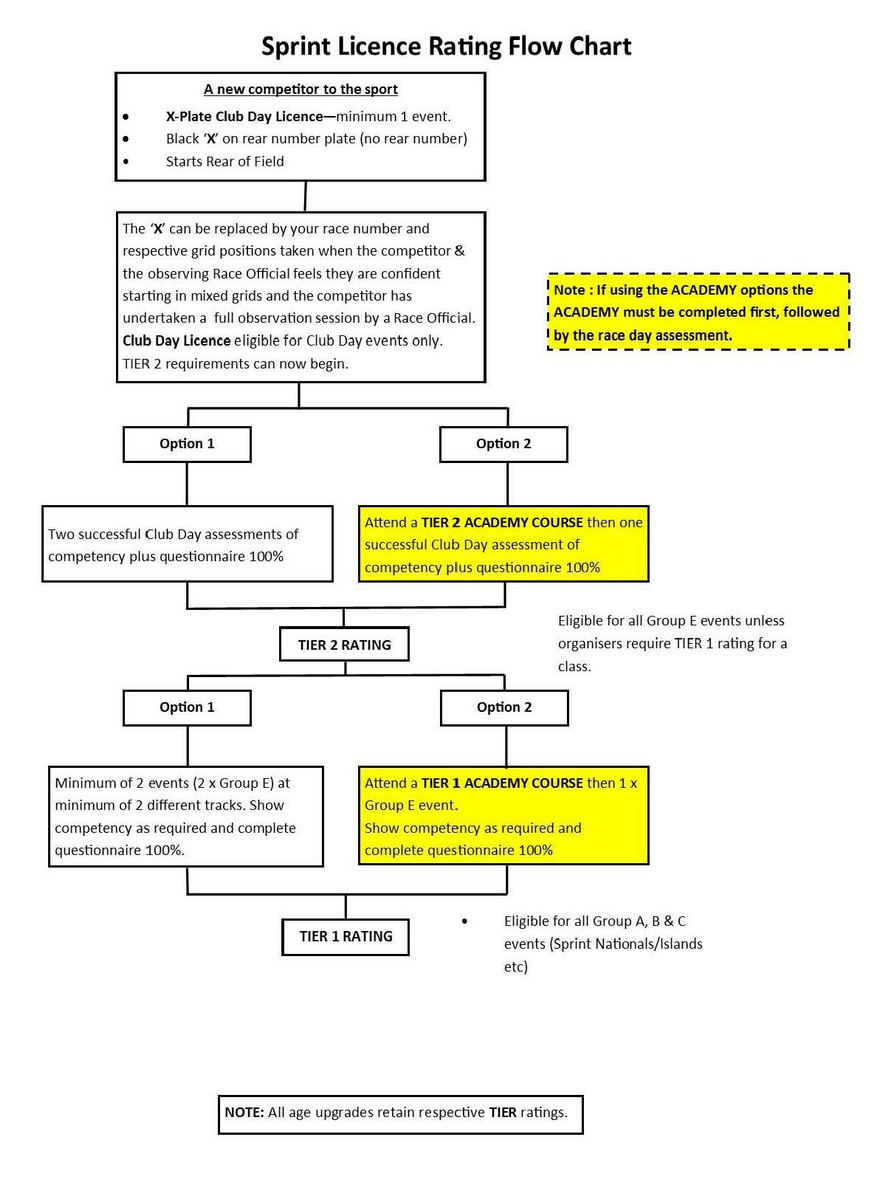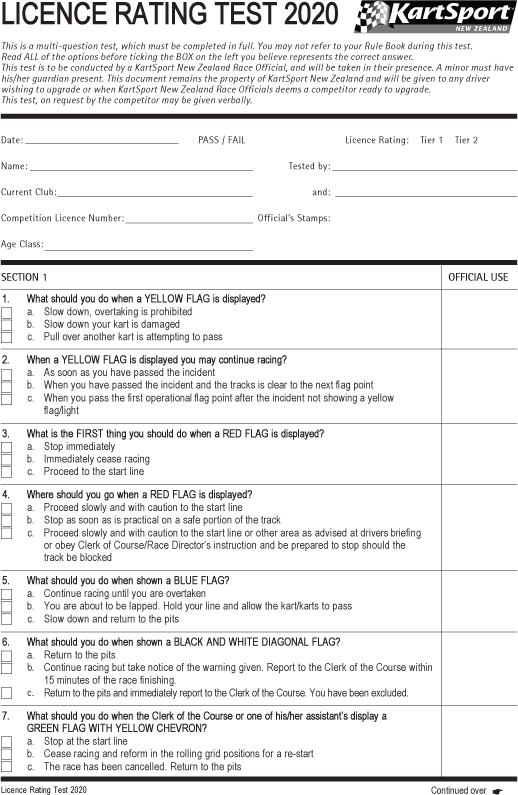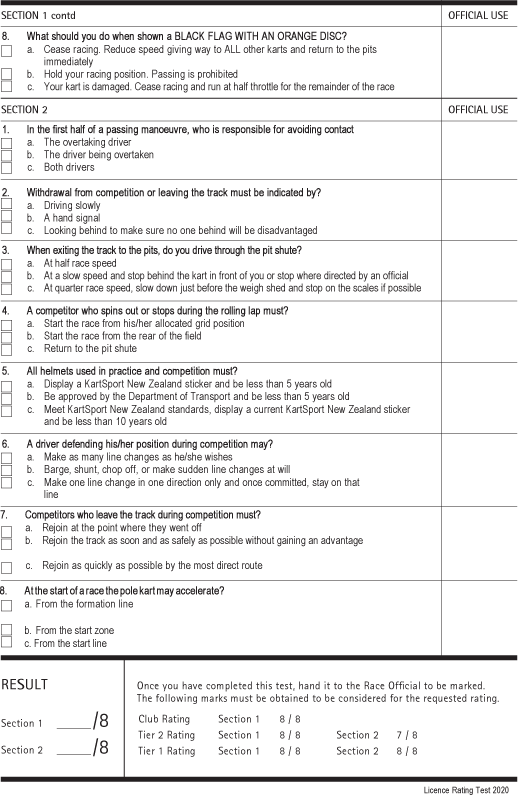This section is applicable to all Race Officials, Chief Steward, Steward’s on the panel, Clerk of the Course/Race Director and Assistant Clerks of the Course.
D3 LICENCE RATINGS:
Rating upgrades can only be made following assessments for Sprint and observations for Road during competition at an event(s).
D3.1 SPRINT:
D3.1.1 ‘X-Plate Club Day and Club Day Licence’
•All new competitors start with a X-Plate Club Day Licence which is valid for Club Day (Group F) competition only.
•New competitors will compete at the rear of the grid with a large black cross ‘X’ only (no race number) on their rear number plate for a minimum of one event.
•The cross ‘X’ may be removed and replaced with the kart number and the respective grid position taken when the competitor and an observing KartSport Official feels they are confident starting in mixed grids and the competitor has undertaken a full observation session by a Grade 1, 2 or 3 Race Official. See On-Track Evaluation Criteria here: Licence Rating Checklist
•The competitor’s competition licence will be updated accordingly to a Club Day Licence which is valid for Club Day (Group F) competition only.
•At any time, a Race Official may re-impose the use of an X-Plate and downgrade the competitor’s competition licence for safety and/or competency reasons.
D3.1.2 ‘Tier 2’ Rating: Required for Group E Events.
•To promote a Club Day Licence competitor to ‘Tier 2’ the competitor’s competition licence must display the new rating, date, name and stamp number of the KartSport New Zealand Grade 1, 2 or 3 Race Official plus the Chief Steward of the event.
•A competitor may enter all events other than those requiring a Tier 1 Licence Rating.
•To move up to Tier 2 the competitor must meet the required Tier 2 competency on track and pass the questionnaire 100% and have competed at the required number of Club Day events. See On-Track Evaluation Criteria here: Licence Rating Checklist.
Option 1: Two successful Club Day assessments of competency plus pass questionnaire 100%.
Option 2: Attend a “TIER 2 ACADEMY COURSE” then one successful Club Day assessment of competency plus pass the questionnaire 100%.
Note: If using Option 2, the ACADEMY course must be completed before the race day observation assessment.
D3.1.3 ‘Tier 1’ Rating: Required for Group A, B and C Events.
•Tier 1 may also be required, at the National Steward’s discretion, for other events.
•To promote a ‘Tier 2’ competitor to ‘Tier 1’ the competitor’s competition licence must display the new rating, date, name and stamp number of the KartSport New Zealand Grade 1 or 2 Race Official and the Chief Steward of the event.
•A competitor may enter any sprint event.
•To move up to Tier 1 the competitor must meet the required Tier 1 competency on track requirements. See On-Track Evaluation Criteria here: Licence Rating Checklist.
Option 1: Minimum of two Group E events at a minimum of two different tracks. Show competency as required and complete the questionnaire 100%.
Option 2: Attend a “TIER 1 ACADEMY COURSE” and then one Group E event. Show competency as required and complete the questionnaire 100%.
Note: If using Option 2 the ACADEMY course must be completed before the race day assessment.
D3.1.4 Licence Rating Exceptions.
Competitors from other forms of motorsport that have held a competition licence issued by their country’s motorsport governing body or a karting competition licence issued by their country’s karting governing body or past KartSport New Zealand Competition Licence holders that can prove appropriate past or current experience, they can apply in writing to the National Steward for a Competition Licence Rating Exception for either a Tier 1, Tier 2, ‘B’ Non Gearbox Road, ‘B’ Gearbox Road, ‘A’ Non Gearbox Road or ‘A’ Gearbox Road Licence Rating depending on their experience. All Licence Rating Exceptions are at the discretion of the National Steward. An introduction from the Chief Steward or their appointee and an on track observation is required at their first event.
D3.2 ROAD
D3.2.1 ‘B’ Non Gearbox Road Rating and ‘B’ Gearbox Road Rating:
A portion of the licence is made available for up to three observations. A competitor may be promoted by a KartSport New Zealand Grade 1 or Grade 2 Race Official plus the Chief Steward of the event after the 1st or 2nd observation providing the required level of competence has been achieved. A new competitor will start at the back of each respective class for the first heat of each race day until such time a ‘B’ Non Gearbox or 'B' Gearbox Road rating has been awarded. Unrated competitors must display a large black ‘X’ only (no race number) on their rear number plate and have their rain light operating as per Rule G1.7 “Road Racing”
D3.2.2 ‘A’ Non Gearbox Road Rating and ‘A’ Gearbox Road Rating.
A competitor may be promoted by a KartSport New Zealand Grade 1 or Grade 2 Race Official plus the Chief Steward of the event. An ‘A’ Non Gearbox or ‘A’ Gearbox rating may be required for some events at the National Steward’s discretion.
D3.2.3 “Non Gearbox” Road Rating Definition:
An engine class listed in Section S of the KartSport New Zealand Rule Manual with two or less gears.
D3.2.4 “Gearbox” Road Racing Definition:
An engine class listed in Section S of the KartSport New Zealand Rule Manual with three or more gears.
| D3.3 | LICENCE RATING UPGRADE: Any competitor requesting a rating upgrade will be assessed/observed in competition and will be required to satisfactorily complete the |
requirements of D3.1 and/or D3.2 respectively before the rating will be considered. The National Steward has discretion to upgrade a licence rating at any time provided he/she is satisfied the required level of competency has been achieved.
D3.4 MSNZ FLAGS/LIGHTS: Competitors must be familiar with the Flags/Lights Section in MSNZ Manual Appendix 4 - Schedule Z:
Below is the Sprint Licence Rating Flow Chart with options to also attend ACADEMY Courses to help gain a rating. If taking the ACADEMY options these courses must be completed first followed by the race day assessment. The Race Day Assessment must always be the final part of the process for sign off of the Licence Rating.

General :-
When completing the multi-choice questionnaire verbal assistance for younger competitors with the questionnaire is acceptable.
•The emphasis of observations should be on safety and not solely on ability, especially, for Club & Tier 2 observations.
•Results in a race should not be considered until Tier 1 Observations.
•Whilst observing Officials should consider:
oNumber of entries in class i.e., if only 3 then driving ability needs to be assessed over position.
oLevel of field. i.e., if a newcomer is racing and being compared to a NZ1 at their club
oA competitor should not be penalised for a lack of numbers at their club. KartSport and Academy Coaches will need to work together in these instances to reach a decision. If not a Coach, this will go to the Chief Steward.
•A KartSport Official has the ability at anytime to drop the rating of a driver or re-instate an X-Plate if they believe a competitor is not fulfilling the skills required at their level and is unsafe and a danger to other competitors
Assessments :-
Drivers wishing to have an assessment for a Tier 1 or Tier 2 licence rating will advise you on the day, ideally before racing starts.
Likewise if they wish to complete the questionnaire you will agree a mutually convenient time with them.
When completing assessments use the Licence Rating Checklist
By mutual consent at the beginning of the event you will select/delegate one of your team of race officials at that event to be the licence rating assessor.
Under no circumstances are Grade 4 race officials permitted to be assessors.
The system is based on the criteria set out in the Licence Rating Checklist
The driver needs as a rule to finish in the top two thirds (2/3rds) of the field.
ie. they need to finish in the top six in a field of nine drivers for example.
But --- if a driver is a candidate for a Tier 1 or Tier 2 rating and at the end of the days racing finishes eighth in a field of nine and everyone ahead of him was a Tier 1 driver! What are you going to do?
Provided they meet the requirements of the Licence Rating Checklist you would sign off their logbook as a successful assessment.
If you have to make a judgement call on the race pace of a driver, take note of this.
We do not want a driver passing a licence rating assessment that is going so slow that he/she is being lapped after six or eight laps!
The track timing system will be of assistance to the licence rating assessor in this regard as well.
You will need to know what a competitive lap time is for that class at that track normally, to assist you with your assessment.
Opinions like “I don’t think you are good enough” are not acceptable.
If the person is being denied a successful assessment, there must be very good quantifiable reasons. eg. You are wanting a Tier 1 licence rating and today you finished 7th in your class of 9 karts. Everyone who finished ahead of you was an unrated driver, sorry but you will not receive a successful assessment today.
Another consideration for you is how to handle the situation when a driver consistently performs within the criteria, ie they're going for a Tier 2 rating and they finish in the top 2/3rds of the field and beat most of the Tier 1 and Tier 2 drivers but his/her kart had mechanical failures in two races and they didn't finish. (DNF) !
If they completed at least a minimum of three of their races satisfactorily then you would sign them off as a successful assessment.
It is impossible to predict all the situations you may encounter but commonsense will need to be applied to some situations!
A successful assessment also requires that the driver does not have a penalty issued against him/her at that event by the Steward's panel! This is important. Regardless of how well they perform on track, any penalty issued by the Stewards Panel (whether as a result of a hearing or as a result of competitor accepting the penalty) immediately deems an assessment unsuccessful.
Questionnaires :-
The questionnaire can be completed at anytime during the assessment process for either rating.
The successful completion of the questionnaire must be noted in the logbook, signed, dated and stamped.
A Tier 2 applicant must achieve 100%.
The copy of the completed questionnaire is to be given to the event Chief Steward for inclusion with his/her event report.
Below is an example only of a licence rating test.


Recording Assessments and Issuing Ratings :-
Recoding assessments and issuing or upgrading licence ratings is done via the KSNZ Digital Licence Mobile App.
For full information and quides on using the App including recording assessments and issuing ratings refer to the details on the KartSport New Zealand website here.
When you are checking licences particularly if you are awarding a Tier 2 rating make sure that the driver is at least 7years old! Check the date of birth carefully.
Once a 6 year old driver has had the X plate removed they can start the assessment process for a Tier 2 rating, they just can't be awarded the Tier 2 until they turn 7 years old.
All drivers at each event, club day or permitted should have their current licence rating listed with their name on the race result sheets to assist the licence rating assessor at the end of the days racing.
Your club race secretary should supply the timekeeper with not just the competitor's name but their current licence rating as well so that the timekeeper can enter their current licence rating alongside their name into the timing system.
Note some drivers may only require a Tier 2 rating because they race only Junior Clubsport 120s.
A Tier 2 rating is the maximum rating for that class so don't give them a Tier 1 unless they ask for one.
Summary :-
The licence rating assessment process is not a single assessment.
You will see from the flow chart above that up to two successful assessments are required but depend on the option selected by the driver before the new licence rating will be awarded.
There is also provision for drivers to reduce the number of race day assessments for both Tier 2 and Tier 1 licence ratings if they attend the appropriate ACADEMY course.
Licence rating downgrades when a karter moves from say Mini ROK to the Junior class do not apply, ie. a Cadet driver once he attains a Tier 1 licence rating keeps that rating through all the other classes including the Senior class. This means that overall there are less licence rating assessments required at events by the Race Officials.
If you take a look at My Laps to familiarise yourself with the race result format, you will be able to get an idea of how far behind the leader the driver was, who was just outside the top two thirds of the class when everyone ahead of him was theoretically Tier 1 drivers!
Was he a quarter or half a lap behind the leader or about to get lapped?
That's a useful practice assessment exercise but also be aware of what is a normal competitive lap time for that class at that track, in case it was a slow race for some reason. (Rain!).
If in any doubt, at the end of the day record the details and seek assistance from a more senior race official or the National Steward.
Because licence rating assessments are not based on personal observation and subjective opinion, the data can be reviewed if necessary and a final decision made after the event.
|
|